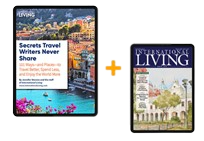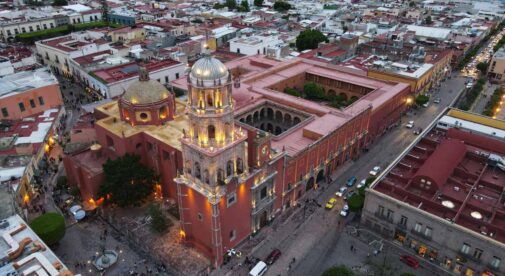I’m a lists person. Whether it’s for shopping, to organize the events of my week, or to plan my next vacation, I’ll make a list for it.
Two years ago, after living in Southeast Asia for 16 years, my husband David and I found ourselves looking for a new overseas home… and that meant another list. There’s no right or wrong method for picking where you might live overseas, but personally, I found that making a list helped me to narrow down my criteria. Which in turn helped me find Santiago de Querétaro, a city in the highlands of central Mexico.
Are you interested in retiring abroad? Yes | Not Sure Yet
Here’s my original list… and how my new hometown compares:
A mid-sized city: My idea of a perfect sized community is between 750,000 and 2 million. That’s big enough to keep it interesting, but not so big that it’s overwhelming. Querétaro’s population is 1.36 million, which is ideal for me.
A spring-like climate: Querétaro has an average annual temperature of 64 F. The warmest days (in April and May) can be in the low 90s F, and the nights are always cool. The humidity is low. The average annual rainfall is 27 inches and nearly all of that occurs between June and September, mostly at night. The weather, for my tastes, is ideal.
Other expats, but not too many: I’d wanted enough expats to have a small circle of friends while still experiencing a mostly local city. Again, Querétaro checked this box. I’ve met a few expats around my age, but so far, nearly all my friends are Mexican. I’ve enjoyed watching my Spanish skills grow as I’m immersed in the culture.
Walkable areas: This is important to me… I like level streets, good sidewalks, and designated pedestrian areas. I don’t want to move to a place where I’ll have to buy and maintain a car. Querétaro has been perfect in this regard. The historic Spanish-colonial center is mostly level, with pink stone sidewalks and gorgeous architecture. It’s compact enough that I can walk nearly everywhere. When I need to go farther afield, the public bus system is decent and taxis or drivers are easily available.
An interesting culture: My list includes living in a culturally rich environment with plenty to see and do. Querétaro has free live music, dance, and art shows every weekend throughout the summer, ballets, concerts, and theater year-round, and more than a dozen museums. The Centro Histórico encompasses more than 200 blocks, and I’m continually discovering picturesque streets with colorful buildings, parks, and plazas.
A dynamic, diverse food scene: I’m a big foodie… and my research showed that the food choices in Querétaro, the fastest growing city in Mexico, have been evolving in the past few years to include some decidedly high-class dining. There are plenty of low-cost choices too—a satisfying midday comida corrida meal is 65 pesos (about $3). Whether you have a taste for central Mexican cuisine, Mexican food from other parts of the country, or fine foods from around the world, new restaurants continue to fill the niches.
Quéretaro checked all nine boxes on my list.
A feeling of safety: It’s important that I feel safe in my new hometown, and Querétaro is regarded as the second safest city in Mexico. When I made my list I was staying in Denver, Colorado, so I compared the crime and safety indexes between the two cities, and Querétaro clearly came out the winner.
Diverse outdoor activities: I wanted to live in a place that makes you want to spend time outside. Querétaro has dozens of parks and walking trails, and it’s a short drive from some spectacular mountains and scenery. The state of Querétaro has several large national parks, natural hot springs, rivers suitable for kayaking and rafting, and countless walking trails. It’s also in the heart of the wine country. Plus, five Pueblos Mágicos (magical towns) are in the state—villages distinguished for their natural beauty, culture and traditions, special cuisines, arts and crafts, or other unique attributes.
Affordability: This is the last item on my checklist, but by no means is it the least important. I was surprised to see that the cost of living in Querétaro is nearly the same as it was in Hanoi, Vietnam, where I was previously living. Utilities are quite a bit less in Querétaro, since the spring-like climate requires neither heat nor air-conditioning. Many grocery items also cost less here; I’ve purchased large shrimp for $6.25 per pound, eggs for $1.50 per dozen, and organic, custom roasted whole-bean Oaxacan coffee for $5.11 per pound.
Obviously, everyone’s list will differ, and although you might not get everything on it, it’s a fun way to identify what truly matters and what the dealbreakers are. I’m now a permanent resident of Mexico, happily living in a town that I love—one that fits every single attribute on my list.

Get Your Free Mexico Report Here:
Learn more about Mexico and other countries in our daily postcard e-letter. Simply enter your email address below and we'll send you a free special report - Why Millions of Americans Are Moving to Mexico.
This special guide covers real estate, retirement and more in Mexico and is yours free when you sign up for our postcards below.
Related Articles
Full Guide to Querétaro, Mexico
5 Places to Live in Mexico…and 3 to Avoid
Upcoming Conferences
The Only 2024 Fast Track Panama Conference
If your dream retirement involves stunning beaches… lush green mountains… a warm climate with no hurricanes… first-rate healthcare… incredible value for money (a couple can live well on $2,200 a month)… and the World’s #1 Retiree Discount Program…
Join our Panama experts and expats in February and discover why Panama could be your perfect paradise.
REGISTER NOW, SEATS LIMITED: EARLY BIRD DISCOUNT HERE



.png)